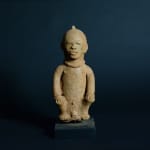Katsina Sculpture of a Seated Man, 500 BCE - 200 CE
Terracotta
36.2 x 15.2 cm
14 1/4 x 6 in
14 1/4 x 6 in
PF.5789
Further images
The Katsina style emerged along with the Nok culture. Discovered through archaeological expeditions in the 1940’s, almost nothing is known about the society or its customs other than the spectacular...
The Katsina style emerged along with the Nok culture. Discovered through archaeological expeditions in the 1940’s, almost nothing is known about the society or its customs other than the spectacular terracotta sculptures they left behind. Alas, were it not for these artifacts, their culture might have been completely forgotten. Fortunately, works such as this Katsina sculpture survive, a hint of the sophistication and beauty of their artistry. These sculptures represent the oldest artistic creations in Sub-Sahara Africa and could be the mother culture that originated the stylistic tendencies that continue to be pervasive throughout black African art today. The most obvious lasting influence is the disproportionate emphasis placed on the head.
This figure sits in a typical Katsina posture with his diminutive bent knees and his hands resting on the kneecaps. Unlike most Nok examples, the Katsina sculptors show little sensitivity in the modeling except for the head. The figure’s coiffure is a simple spherical skullcap with a small central horn at the top and a ring of mounds at the back, wholly different from the elaborate styles of the Nok. His eyes are also treated in a different manner from the wide, almond-shaped eyes that characterize the Nok: they are basically narrow horizontal slits carved into large, overhanging lenticular eyelids. Great attention has been paid to the figure's wide, protruding lips and flat, broad nose. The figure sits adorned in jewelry including a thick beaded necklace and bracelets. What an amazing relic from a lost civilization. This sculpture is a reminder of how vast and bountiful our common cultural heritage really is.
This figure sits in a typical Katsina posture with his diminutive bent knees and his hands resting on the kneecaps. Unlike most Nok examples, the Katsina sculptors show little sensitivity in the modeling except for the head. The figure’s coiffure is a simple spherical skullcap with a small central horn at the top and a ring of mounds at the back, wholly different from the elaborate styles of the Nok. His eyes are also treated in a different manner from the wide, almond-shaped eyes that characterize the Nok: they are basically narrow horizontal slits carved into large, overhanging lenticular eyelids. Great attention has been paid to the figure's wide, protruding lips and flat, broad nose. The figure sits adorned in jewelry including a thick beaded necklace and bracelets. What an amazing relic from a lost civilization. This sculpture is a reminder of how vast and bountiful our common cultural heritage really is.





